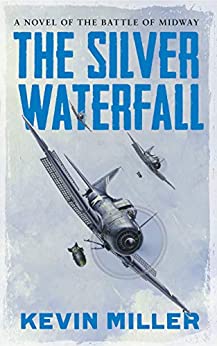New Naval Historical Foundation History Program:
We are excited to announce a new historical program – “Naval History Author Chats” by NHF Staff Historian Dr. Dave Winkler. This week we are sharing our inaugural author chat with Captain Kevin Miller, USN (Ret.), author of The Silver Waterfall: A Novel of the Battle of Midway, which is being published today!
Please click the image above or the link below to listen to this fascinating discussion.
drive.google.com/file/d/1CoFnYrb66ndrZNPwyQoYUf_CK4Z3yFFO/view

Description:
In the desolate middle of the largest ocean on earth, two great navies met, one bent on conclusive battle, the other lying in ambush.
Six months after Pearl Harbor, Yamamoto again crossed the Pacific with the most powerful naval armada the world had ever seen, this time to finish the job. Nimitz waited for him with what he had, placed exactly where he needed it.
Both admirals depended on their fliers, some veterans of battle, others raw and unproven. Striking first meant decisive victory.
This is the story of the men who fought the World War 2 Battle of Midway over three momentous days in June, 1942. Men uncertain, determined, fearful and courageous. Their story is one of daring and unfathomable loss.
The Silver Waterfall is a historic fiction novel of Midway told by today’s master of carrier aviation fiction about those who fought in one of the most pivotal and epic naval battles in world history.
Check out Captain Miller’s new book, The Silver Waterfall, on Amazon
H-Gram 048: The Naval Battle of Okinawa—U.S. Flagships Hit, May–June 1945
By Admiral Sam Cox, USN (Ret.), NHHC. Originally posted on: www.history.navy.mil/about-us/leadership/director/directors-corner/h-grams/h-gram-048.html
75th Anniversary of World War II
This H-gram covers the naval battle of Okinawa from late May to early June 1945, including the kamikaze hits on flagships Bunker Hill (CV-17, Vice Admiral Marc “Pete” Mitscher), New Mexico (BB-40, Admiral Raymond A. Spruance) and Enterprise (CV-6, Vice Admiral Mitscher). All of these ships survived, although the hits on Bunker Hill caused the most casualties in a single ship from a kamikaze attack, with 396 crewmen killed. The mass kamikaze attacks Kikusui No. 6, 7, and 8, and Typhoon Viper are also discussed.
Kamikaze Attacks on U.S. Flagships off OkinawaAs the ground campaign at Okinawa dragged on in a bloody slog against fierce Japanese resistance, Japanese kamikaze aircraft continued to hit U.S. ships around the island in a series of mass attacks of more than 100 aircraft, interspersed with smaller raids that could occur at any hour, creating immense strain on crews that had to react almost instantly to the threat. The great majority of Japanese kamikazes were shot down by U.S. fighters and antiaircraft fire, but planes flown by pilots who intended to die proved very difficult to stop, and invariably some got through even the best defenses.On 11 May, two kamikazes in quick succession hit the carrier Bunker Hill, Vice Admiral Mitscher’s Task Force 58 flagship, at a critical time, when the flight deck was packed with planes that were armed, fueled, manned, and about to launch. The result was a conflagration of unspeakable horror as 396 Americans died or went missing in the flames and suffocating toxic smoke, the largest loss of life aboard a single ship due to a kamikaze attack. Even when it seemed all hope was lost, Bunker Hill’s gunners kept shooting, and her damage control teams never quit. They saved the ship, although she would never be operational as an aircraft carrier again. (Mitscher’s chief of staff, Commodore Arleigh A. Burke, was awarded a Silver Star for extricating men from a burning compartment.)
Read the full H-Gram on NHHC’s website HERE
Naval History News, Announcements, and Anniversaries


